 |
  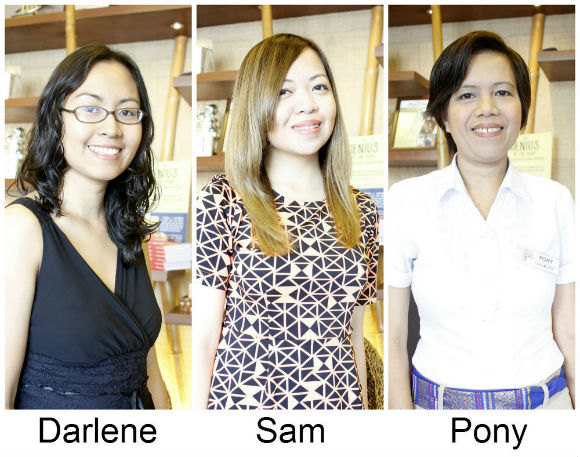 What is your New Year's Resolution? "Simplify! I realized while packing for our new home that only a few important things bring real value to my life. So now, all I own, consume, commit to, and do, I try to winnow through with two questions: Do I need it? Do I deeply desire it? If the answers are no, then it's only excess baggage. :)" - Darlene, Digital & Social Media Head "This 2015, I would like to have a more holistic approach to life. That would mean exercising more, meditating more, and eating healthier food. I'm also aiming to see new places for more culture soaking, culinary adventures and overall self-discovery."- Sam, Senior Copywriter "Last year was not a really good year for me [with] the loss of my mother and after almost 2 months only the sister of my mother. I was sick afterwards. I am still recovering from the loss. So maybe this year my new year's resolution would be mag-ipon, at mag-ipon ulit. Gusto ko magkabahay. Maybe stay healthy."- Pony, Assistant Store Manager |
 Human Nature Merchandisers' Store Target Success! It was a fruitful year for our Human Nature merchandisers as many of them reached the milestone of hitting their store targets for the very first time. This achievement does not go unnoticed by our Retail Operations team, whose daily efforts are geared towards the success of Human Nature's celebrated heroes. All hands on deck With 57 Human Nature merchandisers, 4 coordinators, and 4 administrative officers on deck, each key player has a pivotal role to play in reaching store targets, which vary per store and are based on historical growth. At present, Human Nature merchandisers are present in Robinson's Supermarket, Rustans Supermarket, Shopwise, Landmark, Beauty Bar, and Waltermart."All that we do revolves around collaboration," explains Tin Fernandez, Retail Operations Supervisor. "Merchandisers and coordinators ensure that we do excellent work in the frontline, while our administrative officers do their magic at the backend." Support system Our merchandisers' store target success can largely be attributed to the intertwining efforts of various key players, who build upon the dedication of our merchandisers and keep pushing forward."[The cause of their success is] actually difficult to pin down since it's a cocktail of sorts - of availability, visibility, collaboration, discipline, and a bushel and a peck of passion," elaborates Tin. "We also receive tremendous amount of support from other departments to make sure that our products reach retail at the right time. Our training team also tirelessly works to mentor our merchandisers." In line with Human Nature's mission to become the gold standard of a globally successful enterprise with a heart, our merchandisers believe in delivering world-class work. "Merchandisers and coordinators secure and fight for our visibility to ensure that our displays are at par with (if not better than) our multinational competitors," she continues. "When we are well-displayed, we have greater chance of attracting customers. This is complemented with the customer service that our merchandisers provide - this could be in the form of push selling, cross-selling, upselling, or simply getting our customer queries answered." Living advocacies When it comes to their achievements, our merchandisers remain humble yet motivated. "Whenever I ask our merchandisers what motivates them, the common denominator is their family," Tin shares. "But their motivation also goes beyond monetary compensation. I am amazed at how passionate our merchandisers are in spreading our advocacies. They know that they are enablers of our advocacies. This in mind pushes them to do well.""They are our living advocacies," emphasizes Tin. "They are our ambassadors. They know their stores inside-out. They are our first line of contact with our customers in Retail. They are our eyes and ears in the stores giving us invaluable insights - Insights that turn into products, promos or improvements. They contribute in our sales. And as for me, they give me reason to go to work because I know I am surrounded with a great team who has the heart of a hero." Our heartfelt congratulations, merchandisers! |
 A Trip As Sweet As (Coco) Nectar by Tish Martinez-Castillo, with photos by Romel Dulay Proof of concept At least 70 percent of Quezon province residents depend on coconut plantations to survive.The national average income of coconut plantations producing copra and whole nuts is only Php900 per hectare per month. In contrast, plantations producing cocosap for coco nectar earn 7,500 pesos per month, almost. But by producing cocosap for coco nectar production, farmers get Php7,500 per hectare per month – that's almost 8 times more what they can earn from copra. One liter of coconut nectar can be harvested from each tree per day. "We help social enterprises scale up by providing them with tools, training, and of course -- a market," explained Mike Go. Coco nectar sourced from Mauban is also an active ingredient in Human Nature's natural shampoos and Furry Kind Cocomutt Shampoo. "After we started selling through Human Nature branches, our business has grown close to 500 percent," beamed Frank. "While I'm talking with other coconut plantation owners so we can harvest more; one of the main challenges we have right now is finding enough mangagaret (coco sap gatherers) to harvest the coco sap." Frank's production facility can process 400 gallons of coco sap each day, producing around 250kg of coco nectar. Home sweet home A few meters away from the coco nectar facility is a Gawad Kalinga village with over 200 residents. There, we met Vangie Catubig, a GK Kapitahayan leader. Vangie hopes that the coco nectar plant will flourish and be able to employ more residents from the GK Liwayway Village."Kawalan po ng permanenteng trabaho ang number one naming problema dito (Many of us do not have permanent jobs, that's our number one problem here)," she shared, quickly adding that they are trying to grow as much crops as they can in their community's vegetable and fruit garden, dubbed 'Bayan-anihan', to ensure that no one goes hungry. Eggplant, okra, string beans, petchay, mustasa, and cassava are just some of the crops growing in GK Liwayway. Frank's assistant, Jaycel delos Santos, is a resident of GK Liwayway. She shared that working in the coco nectar facility has greatly improved her family's quality of life. "I can help send my siblings to school and save up for my future now," she beamed. It seems apt for a social enterprise to spring from a barangay named Liwayway (dawn). Perhaps, dawn is truly breaking in a province that has been so wrapped in the darkness of poverty for decades. 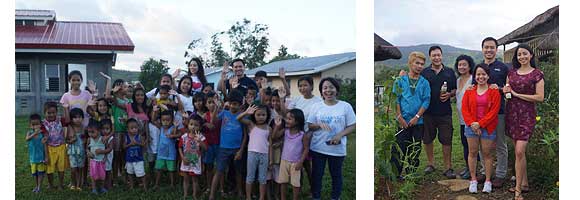 Inspiring others to do well As Human Nature's Global Ambassador, Rachel shares many of her experiences in the Philippines during speaking engagements and via her wide online base."It's been a year since I was here and even in one year I can see that so many new products have been developed. I like to look at the new products – like what Tito Frank is doing and I feel really proud about it...because they're from the Philippines...it's inspiring," enthused Rachel. "I get a lot of emails and Facebook messages, and I am surprised when they say: "Oh, you inspired me to do this, to join this marathon, to raise money for this purpose, or donate to GK villages, or people ask me all the time on how they can work for Human Nature..." I tell them, I am one of the people who have been inspired too by what Human Nature is doing." We also made a quick visit to Human Nature's manufacturing plant in Carmelray, Laguna. Rachel added that in the future, her presentations will include how just wages and paying the right taxes are not roadblocks to a company's growth. "I was thinking about how the Philippines has changed...it's getting better! It's all about the growth of goodness, working towards a better world." With businesses like Uncle Frank's Green Processing Enterprises engaging more of the rural poor; the future of the Philippines looks so sweet, we can almost taste it. |
| Thank You, Tambulilid By Tish Martinez-Castillo No Tears Say "Typhoon Yolanda" and what immediately springs to mind are chilling headlines - details of devastation and death.When I met with the nanays in Tambulilid, I expected sob stories. These people, after all, had lost all of their possessions. These mothers, after all, lost their friends and family to one of the strongest tropical cyclones in history. But I found no tears in Tambulilid. Instead, I was met with smiles everywhere I went. I encountered outpourings of gratefulness at every turn and more hope that I could possibly imagine. These people, the so-called "Yolanda victims," were wellsprings of positivity. 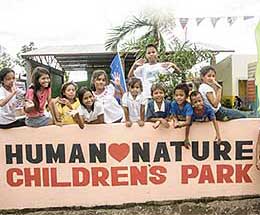 In Tambulilid, I met Nanay Paping Lauron, a 74-year old lady who was part of my "work group". Nanay Paping and I hauled sand together. I asked her why she insisted on building houses in Tambulilid each day. "Gusto ko tulungan kapitbahay ko, sama-sama kami dito. Pa konti-konti lang, ang trabaho, yung kaya lang ng katawan ko," she said. It was that simple. In Tambulilid, I met Nanay Paping Lauron, a 74-year old lady who was part of my "work group". Nanay Paping and I hauled sand together. I asked her why she insisted on building houses in Tambulilid each day. "Gusto ko tulungan kapitbahay ko, sama-sama kami dito. Pa konti-konti lang, ang trabaho, yung kaya lang ng katawan ko," she said. It was that simple. During one afternoon, I took to writing down the names of the people I met. Some children asked me why I was listing them down and if it was a palista for relief goods or school supplies. I told them I was writing down the names of Tambulilid residents so I'd remember them and be able to pray for them when I went back to Manila. I thought that the children would lose interest. Instead, they volunteered their names, the names of their siblings and friends, the names of their parents...virtually anyone they could think of. One even ran off to her mother to ask for the names of other relatives. I wrote everything down feverishly, determined to remember all the names they entrusted. GK Human Nature Turnover Last December 17, 2014, I travelled to Tambulilid together with Dylan, Camillie, Wowie, and other colleagues to witness the turnover ceremony of houses. I was in a daze when we arrived. Tambulilid was unrecognizable. In place of the torn down concrete and overgrown vegetation were rows of colorful houses, already inhabited by some of the residents. There were small vegetable patches where piles of rubbish once were. Children were busy playing in the Human Nature Children's Park and at the Sibol School - places which were filled with drift wood and metal scraps last May. A spacious and new multi-purpose hall stood beside some structures that were destroyed by Typhoon Yolanda - a reminder, perhaps, that the work was far from over. During the program, Tito Boboy Igot, an Ormoc-based GK worker spoke on how the community never lost hope even as they struggled to recoup their losses. "We did not know where help would come from, but we knew God would not let us down," he shared. Igot added that Tambulilid was a relocation site for survivors of Typhoon Uring, a deadly typhoon that hit Leyte in the 1990s. "It is like we are brought together and made even stronger by storms." Tambulilid is one of the first GK sites in the Visayas.  As I was listening to Tito Boboy and the testimonials of Tambulilid residents; I reflected on what seemed impossible (nay, a little insane) in 2013: for a young company like Gandang Kalikasan Inc. to raise 15 million pesos in funding to build 100 houses in Ormoc. Not only have GKI employees, Human Nature advocates, and customers succeeded raising enough funds for building 100 homes in Tambulilid; we have actually gone over the 100-home mark and have extended our reach to Cadiz Viejo in Negros. But while ensuring that the goals of Goodness Rising are met is no mean feat, I am positive that our burden was the lightest. We owe the completion of Human Nature's first GK Village to our partners in Ormoc - the tireless GK workers and the residents who never lost hope. They are the true heroes. Daghang salamat, Tambulilid. |
  Would you like to share your good news and inspirational stories with the rest of our Human Nature family? Send your goodness stories to nicole.sa@humanheartnature.com! Three stories will be featured each month, so come and share the goodness! Would you like to share your good news and inspirational stories with the rest of our Human Nature family? Send your goodness stories to nicole.sa@humanheartnature.com! Three stories will be featured each month, so come and share the goodness!  |
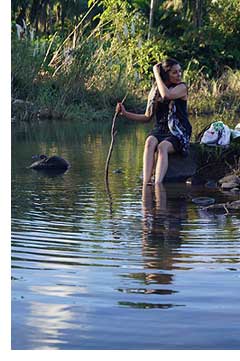 "I should've done some warm up exercises," I thought as I struggled to keep up with the wide strides of Rachel Grant, Human Nature's Global Ambassador during our descent to a creek in Barangay Liwayway in Mauban, Quezon province. We were maneuvering down a slope filled with thick, dry bushes, small trees, and wild vines.
"I should've done some warm up exercises," I thought as I struggled to keep up with the wide strides of Rachel Grant, Human Nature's Global Ambassador during our descent to a creek in Barangay Liwayway in Mauban, Quezon province. We were maneuvering down a slope filled with thick, dry bushes, small trees, and wild vines. 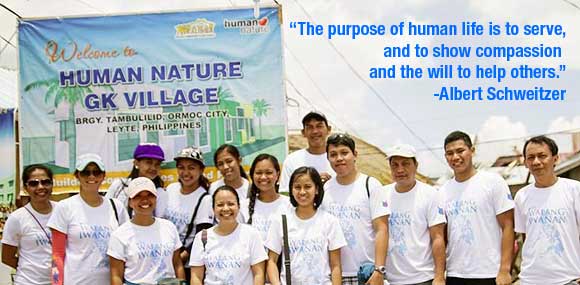
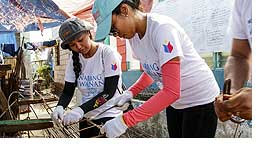 The Bayani Challenge is the country's largest showcase of volunteerism to date. From April 9 to June 12, Bayani Challenge gathered over a million volunteers to serve 12 provinces across the Philippines. Bayani Challenge activities included feeding local children, repairing schools, fixing fishing boats, and of course, rebuilding communities devastated by 2013's Typhoon Yolanda. While I had doubts about my house-building abilities, I went to Ormoc because I wanted to see where our "Goodness Rising" efforts were going.
The Bayani Challenge is the country's largest showcase of volunteerism to date. From April 9 to June 12, Bayani Challenge gathered over a million volunteers to serve 12 provinces across the Philippines. Bayani Challenge activities included feeding local children, repairing schools, fixing fishing boats, and of course, rebuilding communities devastated by 2013's Typhoon Yolanda. While I had doubts about my house-building abilities, I went to Ormoc because I wanted to see where our "Goodness Rising" efforts were going.